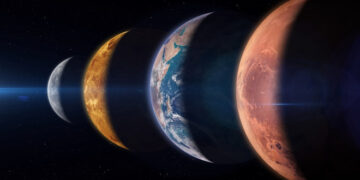Every so often, the universe treats us to extraordinary celestial events that capture our imaginations and remind us of our place in the cosmos. This year, on February 28, 2025, the night sky will showcase one such spectacle—a rare planetary alignment often referred to as a “planetary parade.” On this evening, Saturn, Mercury, Venus, Jupiter, Mars, Uranus, and Neptune will align, creating an awe-inspiring display visible from nearly anywhere on Earth.
What Is a Planetary Alignment?
Planetary alignments occur when planets appear to cluster along a single line in the sky. This phenomenon results from the fact that all planets in our solar system orbit the Sun on nearly the same flat plane, known as the ecliptic. From Earth’s perspective, when planets move into similar positions along this plane, they appear aligned in the night sky.
The rarity of seven-planet alignments adds to their appeal. While smaller alignments of two to four planets are relatively common, alignments involving all visible planets are much rarer. The last time an event of this scale occurred was in 2022, making this year’s planetary parade a must-see.
Why planets never form a perfect line. Although they appear aligned to us, the planets are actually spread out across vast distances. Their orbits are slightly tilted relative to the ecliptic plane, so a perfectly straight alignment isn’t possible.
The February 28, 2025, Planetary Parade
The Participants
This celestial lineup features all seven planets in our solar system besides Earth:
- Mercury: The smallest and fastest planet, closest to the Sun.
- Venus: The brightest and most visible due to its reflective cloud cover.
- Mars: The Red Planet, known for its distinct hue.
- Jupiter: The largest planet, often accompanied by its visible moons.
- Saturn: Renowned for its iconic rings, which can be seen with a telescope.
- Uranus and Neptune: The outermost planets, requiring binoculars or telescopes for observation.
What Makes This Event Special?
A rare alignment of seven planets. While planetary alignments happen every year, this specific event involves seven planets, making it a standout celestial occurrence. Such alignments give us a unique opportunity to witness multiple planets simultaneously.
Long-lasting visibility. The alignment will not be confined to just one night. While February 28 is the peak date, some planets will remain visible together for several days before and after the event. This extended viewing window increases the chances of clear skies and optimal observation.
Observing the Alignment: Tips for Stargazers
When and where to look. The alignment will be visible shortly after sunset, with Venus and Jupiter likely to appear first as the brightest objects in the sky. Depending on your location, the planets will spread out across the horizon in a sweeping arc.
Choose a dark-sky location. Urban light pollution can significantly hinder your ability to see the planets clearly, especially dimmer ones like Uranus and Neptune. Head to a rural area or a designated dark-sky reserve for the best views.
Use the right tools. While Venus, Jupiter, Mars, and Saturn are bright enough to see with the naked eye, Uranus and Neptune require optical aids like binoculars or telescopes.
Astronomy apps make alignment tracking easy. Smartphone apps like Stellarium or SkySafari can help you locate and identify the planets in real time.
Check weather forecasts. Cloud cover can spoil even the most spectacular celestial events. Use weather apps to plan your viewing session on a clear night.
The Science Behind Planetary Alignments
Why do alignments happen? The planets’ varying orbital speeds and distances from the Sun result in periodic alignments. For instance, Mercury completes its orbit in just 88 Earth days, while Neptune takes a staggering 165 years. These differing speeds create opportunities for planets to cluster along the ecliptic.
The role of gravity and orbital mechanics. The gravitational pull of the Sun keeps the planets on their orbital paths, while their individual velocities prevent them from collapsing inward. This delicate balance allows alignments to occur over predictable intervals.
Cultural and historical significance. Throughout history, planetary alignments have inspired myths, astrological interpretations, and even scientific curiosity.
Scientific advancements. Studying alignments helps scientists refine models of planetary motion and orbital mechanics.
Misconceptions About Planetary Alignments
Debunking myths. Some people mistakenly believe that alignments cause significant gravitational effects on Earth, such as natural disasters. In reality, the gravitational pull of planets during an alignment is negligible compared to the Moon’s influence on Earth’s tides.
Clarifying the term “alignment.” While “alignment” might suggest a perfectly straight line, this is never the case. The planets’ slight orbital tilts ensure that alignments are always approximate, adding a layer of complexity to their beauty.
Conclusion
The great planetary alignment of February 28, 2025, is more than just a visual treat—it’s a celebration of the universe’s intricate mechanics and a chance to connect with the cosmos. Whether you’re a seasoned astronomer or a casual observer, this event offers a rare opportunity to witness the grandeur of our solar system.



















